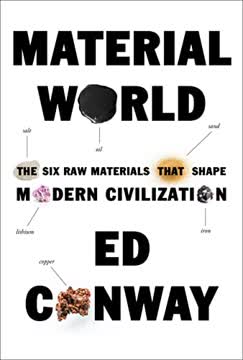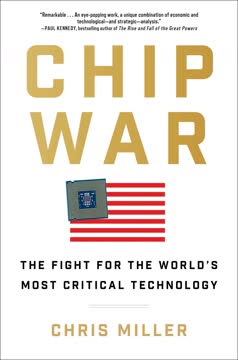Key Takeaways
1. Class Warfare, Not Geopolitics, Drives Trade Wars
A global conflict between economic classes within countries is being misinterpreted as a series of conflicts between countries with competing interests.
Misinterpreted conflicts. Trade wars are often framed as geopolitical struggles between nations, but the root cause lies in internal class conflicts. Massive income transfers to the wealthy within countries distort economies, creating gluts and imbalances that spill over internationally. This internal conflict is then projected onto the global stage as a series of trade disputes.
Inequality's impact. Rising inequality within countries deprives regular people of purchasing power, leading to underconsumption and overproduction. This, in turn, creates a need for external markets to absorb the excess goods, intensifying competition and conflict between nations. The real conflict is between economic classes within countries, not between countries themselves.
Historical parallels. The current situation mirrors the late 19th and early 20th centuries, where extreme inequality in Europe led to imperialism as a means of finding outlets for surplus capital and goods. Similarly, today's trade conflicts are a result of massive wealth transfers to the rich, echoing historical patterns of inequality-driven international tensions.
2. Obsolete Trade Models Obscure Modern Realities
Trade today looks nothing like it did before. Unfortunately, in spite of all these changes, the popular understanding of trade continues to be based on obsolete eighteenth-century models.
Evolution of trade. International trade has evolved from simple exchanges of finished goods and raw materials to complex global value chains. Companies now spread production processes across multiple countries to maximize efficiency and minimize taxes, a far cry from the models of Adam Smith and David Ricardo.
Transnational supply chains. Modern trade is dominated by intermediate inputs within these networks, with finished goods accounting for only a third of international trade. This makes conventional bilateral trade data a poor measure of actual value created by workers and machines in each country.
Tax avoidance distortions. Corporate tax avoidance further distorts trade data, as companies shift profits to low-tax jurisdictions, artificially depressing exports and elevating imports. This makes standard bilateral figures deeply misleading, necessitating a more comprehensive understanding of cross-border money flows.
3. Financial Flows Dictate Trade Imbalances
Financial imbalances now determine trade imbalances.
Finance over trade. International financial flows, driven by factors beyond rational investment, now determine trade imbalances. These factors include speculation, capital flight, mercantilism, and the desire for safety, making any connection between rising trade and broader prosperity accidental.
Credit cycles. Major capital flows do not respond to changes in underlying trade conditions or growth prospects but are mainly consequences of changing liquidity conditions in major banking economies. Institutional changes that lead to increases or decreases in the global credit supply transform investor perceptions of individual countries' real economic prospects.
Historical patterns. The history of international lending booms reveals that changes in global financial conditions often matter more than local growth prospects. Synchronized credit cycles, driven by changes in global credit supply, transform economies and push them to adjust their import and export levels.
4. Savings Glut Distorts Global Economy
Regular people everywhere are being deprived of purchasing power—and tricked by chauvinists and opportunists into believing that their interests are fundamentally at odds.
Abundance vs. scarcity. In an age of abundance, the traditional economic model of suppressing consumption to fund investment is counterproductive. Instead, it leads to lower production, excess capacity, and ultimately, lower living standards.
Savings and investment. While global saving and investment are equal by definition, imbalances arise when some countries produce more than they use domestically, while others produce less. These imbalances are reconciled through trade, with surplus countries exporting excess output to deficit countries.
Income distribution. The savings rate of any country is determined by how income is distributed domestically, not by cultural factors or attitudes toward thrift. Systematic transfers of wealth from workers to the rich distort economies by strangling purchasing power and subsidizing production.
5. China's High-Savings Model Fuels Global Imbalances
Systematic transfers of wealth from Chinese workers to Chinese elites distort the Chinese economy by strangling purchasing power and subsidizing production at the expense of consumption.
Development model. China's high-savings model, characterized by suppressed consumption and prioritized investment, has fueled its rapid economic growth. However, this model has also created significant global imbalances by generating a massive trade surplus.
Internal distortions. Systematic transfers of wealth from Chinese workers to elites distort the Chinese economy by strangling purchasing power and subsidizing production at the expense of consumption. This, in turn, distorts the global economy by creating gluts of manufactured goods and bidding up the prices of assets.
Rebalancing imperative. Reversing China's imbalances requires shifting purchasing power back to Chinese workers and retirees, a politically challenging task given the entrenched interests that benefit from the status quo. This rebalancing is crucial for both China's long-term stability and the health of the global economy.
6. Germany's Austerity Exports Economic Pain
As in China, European workers are increasingly unable to afford what they produce. Since the start of 2010, household spending in the euro area has grown at barely half the rate of overall production.
Austerity measures. Germany's economic policies, including consumption taxes and labor market deregulation, have suppressed domestic demand and created a large trade surplus. This surplus has been exported to other European countries, forcing them to tolerate rising unemployment and soaring indebtedness.
European crisis. The European crisis was never about a conflict between fascistic Germans and dishonest Greeks—it was about income distribution. German policies transferred purchasing power from workers and retirees to the ultrarich, which in turn forced Germany’s neighbors to tolerate some combination of rising unemployment and soaring indebtedness.
Consequences of austerity. The German government's fanatical opposition to public borrowing, epitomized by the Schuldenbremse, has squeezed infrastructure investment and sapped private sector purchasing power. This has not only harmed Germany but also contributed to the broader European crisis.
7. America's "Exorbitant Burden" Sustains Imbalances
Some combination of falling employment and rising indebtedness outside of China was the inevitable consequence. Americans have borne much of these costs, thanks in part to the collusion of U.S. business interests with Chinese politicians and industrialists.
Global demand. For decades, the United States has been the world's indispensable spender, absorbing excess savings and production from surplus countries. This has come at the cost of deindustrialization, financial crises, and rising household indebtedness.
Dollar dominance. The U.S. dollar's status as the world's premier reserve currency has imposed an "exorbitant burden" on the American economy. Foreign governments' demand for dollar-denominated assets has inflated asset prices, suppressed borrowing costs, and kept the dollar elevated, undermining U.S. competitiveness.
Financial system. The U.S. financial system has responded to these pressures by creating new assets to accommodate foreign demand, leading to a massive expansion in mortgage credit and a decline in lending standards. This has fueled unsustainable consumption and investment patterns.
8. Rebalancing Requires Internal Reform, Not External Pressure
Convincing Chinese elites to allow Chinese workers to consume a greater share of what they produce is one of the great policy challenges of our time.
Ineffective tariffs. Tariffs and nationalist rhetoric will not resolve global imbalances but will likely reinforce the mistaken belief that countries have incompatible economic interests. Mishandling legitimate grievances could threaten international peace without addressing the underlying problems.
Internal reforms. Rebalancing the global economy requires internal reforms in surplus countries to shift purchasing power from elites to ordinary people. This includes land reform, hukou reform, tax reform, privatization, and the legalization of unions.
Global cooperation. Moderate redistribution within nations can peacefully resolve the economic conflicts between them. The challenge is an intellectual one (getting people to appreciate this perspective) and a political one (defeating entrenched interests that benefit from the status quo).
Last updated:
Review Summary
Trade Wars Are Class Wars received mostly positive reviews, praised for its insightful analysis of global trade imbalances and their connection to domestic inequality. Readers found the book's historical context and economic explanations enlightening, though some felt it was too technical for laypeople. The authors' argument that trade surpluses result from suppressed domestic consumption and wages resonated with many. Critics noted the book's focus on policy solutions without addressing political feasibility. Overall, reviewers considered it a thought-provoking contribution to understanding modern economic issues.
Similar Books









Download PDF
Download EPUB
.epub digital book format is ideal for reading ebooks on phones, tablets, and e-readers.




